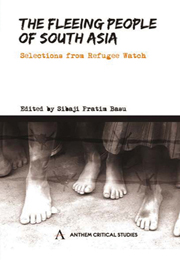Book contents
- Frontmatter
- Contents
- Acronyms and Abbreviations
- Foreword by Ranabir Samaddar
- Preface
- ETHICAL ISSUES
- LAWS
- SOUTH ASIA
- INDIA
- Introduction
- Population Displacement in India: A Critical Overview
- Reporting from Gagan Geer: A Kargil War Refugee Camp
- Barricaded Kashmiri Pandits Letting Go the Right to Return?
- Homeless and Divided in Jammu and Kashmir
- Internal Displacement in North-East India: Challenges Ahead
- The North-East Today: Displacing Identities, Displaced Identities
- Tibetan Refugees in India: Surviving in Exile
- Unrest and Displacement: Rajbanshis in North Bengal
- Adivasis in Coal Mining
- GENDER
- INTERVIEW/CORRESPONDENCE
- REPRESENTATIONS
- Index
Population Displacement in India: A Critical Overview
from INDIA
Published online by Cambridge University Press: 05 March 2012
- Frontmatter
- Contents
- Acronyms and Abbreviations
- Foreword by Ranabir Samaddar
- Preface
- ETHICAL ISSUES
- LAWS
- SOUTH ASIA
- INDIA
- Introduction
- Population Displacement in India: A Critical Overview
- Reporting from Gagan Geer: A Kargil War Refugee Camp
- Barricaded Kashmiri Pandits Letting Go the Right to Return?
- Homeless and Divided in Jammu and Kashmir
- Internal Displacement in North-East India: Challenges Ahead
- The North-East Today: Displacing Identities, Displaced Identities
- Tibetan Refugees in India: Surviving in Exile
- Unrest and Displacement: Rajbanshis in North Bengal
- Adivasis in Coal Mining
- GENDER
- INTERVIEW/CORRESPONDENCE
- REPRESENTATIONS
- Index
Summary
Although forced migration in India is usually divided into two broad types – internal and external, depending on the territorial expanse within which it occurs, we propose to concentrate more on the first type for reasons not beyond our comprehension.
First, while the problem of immigration from across the international borders has been a topic of frequent discussion and responsible for sparking off many a nativist outburst in different parts of India, the issue of internal displacement has assumed alarming proportions especially in recent years, but has hardly received any attention worth its name in popular circles. There is no denying the fact that the issue of internal displacement is yet to acquire the kind of legal standing – whether national or international, that is usually accorded to the external one – particularly of the refugees. Secondly, whereas India's role as a refugee receiving country has been widely acclaimed both within the country as well as abroad, her role in generating refugees has been of marginal significance compared to that of some of her next-door neighbours. This, however, does not leave any room for complacence, and the pressures on the state to adopt certain pre-emptive and corrective measures are now formidable. […] Thirdly, it is difficult, if not impossible in some cases, to make a watertight distinction between these two types for much of what we call, internal displacement is externally induced and has international spillovers at least in the neighbouring regions.
- Type
- Chapter
- Information
- The Fleeing People of South AsiaSelections from Refugee Watch, pp. 229 - 233Publisher: Anthem PressPrint publication year: 2009



